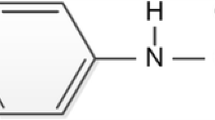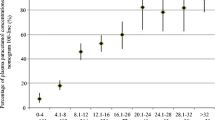Abstract
Paracetamol (acetaminophen) is the most common drug taken in overdose in the UK, accounting for 48% of poisoning admissions to hospital and being involved in an estimated 100–200 deaths per year. In 1998, the UK government introduced legislation that reduced the maximum pack size of all non-effervescent tablets and capsules containing aspirin (acetylsalicylic acid) or paracetamol that can be sold or supplied from outlets other than registered pharmacies from 25 to 16 tablets or capsules. This article reviews the literature to determine the effectiveness of the legislation, focusing specifically on paracetamol poisoning. Seventeen studies on this subject were identified. Three studies found reductions in mortality rates; one study found an increase in mortality rates, while one found an initial reduction followed by an eventual increase; three found no significant difference in mortality rates before and after introduction of the legislation. Five studies found reductions in admissions to liver units, three of these finding a reduction in liver transplantation rates; two further studies found no change in liver function tests and rates of paracetamol-induced acute liver injury or failure. Four studies found a sustained decrease in hospital admissions, while two found an initial decrease followed by an eventual increase. One study found a decline in admissions for paracetamol poisoning and an increase in admissions for non-paracetamol poisoning. Sales data are conflicting, with two studies finding no significant difference in paracetamol sales before and after the introduction of the legislation and one reporting a decline. The severity of overdose appears to have decreased since the maximum permitted packet size was reduced, with five studies reporting a reduction in the number of severe overdoses (measured by numbers of tablets ingested, serum paracetamol concentrations and usage of antidotes). Only two studies reported an increase in the number of severe overdoses.
Paracetamol-associated mortality rates, admissions to liver units/liver transplants, hospital admissions and the severity of paracetamol overdose appear to have been decreasing since 1998. However, one study showed that the reductions in mortality and hospital admissions began in 1997; therefore, the contribution of the 1998 legislation to the observed changes is unclear. Most of the studies are based on short-term follow-up so it is difficult to draw any conclusions regarding long-term trends. Many of the studies were also restricted to relatively small areas of the UK; this, combined with a variety of outcome measures, makes it difficult to distinguish any conclusive trends. The studies also suffer from a lack of comparison and control groups. Some studies do not clearly differentiate between the paracetamol preparations covered by the legislation and those not.
The limited number of studies to date, combined with a variety of outcome measures, make it difficult to determine with accuracy whether or not the legislation has been a success. More long-term studies are needed to fully assess the impact of the legislation.




Similar content being viewed by others
References
Hawton K, Ware C, Mistry H, et al. Paracetamol self-poisoning. Characteristics, prevention and harm reduction. Br J Psychiatry 1996; 168(1): 43–8
Makin AJ, Wendon J, Williams R. Management of severe cases of paracetamol overdosage. Br J Hosp Med 1994, 13
Statutory Instrument 1997 No. 2045. The Medicines (Sale or Supply) (Miscellaneous Provisions) Amendment (No. 2) Regulations 1997 [online]. Available from URL: http://www.opsi.gov.uk [Accessed 2007 Mar 28]
Statutory Instrument 1997 No. 2044. The Prescription Only Medicines (Human Use) Amendment Order 1997 [online]. Available from URL: http://www.opsi.gov.uk [Accessed 2007 Mar 28]
Statutory Instrument 1998 No. 3105. The Medicines for Human Use (Marketing Authorisation Etc.) Amendment Regulations 1998 [online]. Available from URL: http://www.opsi.gov.uk [Accessed 2007 Mar 28]
Laing WJ, Gordon LD, Lee DS, et al. Have the new pack size regulations impacted on UK paracetamol overdose? J Toxicol Clin Toxic 2001; 39(3): 301
Hawton K, Townsend E, Deeks J, et al. Effect of legislation restricting pack sizes of paracetamol and salicylate on self-poisoning 479 in the United Kingdom: before and after study. BMJ 2001; 322(7296): 1203–7
Hawton K, Simkin S, Deeks J, et al. UK legislation on analgesic packs: before and after study of long-term effect on poisonings. BMJ 2004; 329(7474): 1076
Inglis JHC. Restricting sales of paracetamol tablets: effect on deaths and emergency admissions for poisonings in Scotland 1991–2002. Scot Med J 2004; 49(4): 142–3
Bateman DN, Gorman DR, Bain M, et al. Legislation restricting paracetamol sales and patterns of self-harm and death from paracetamol-containing preparations in Scotland. Br J Clin Pharmacol 2006; 62(5): 573–81
Morgan O, Griffiths C, Majeed A. Impact of paracetamol pack size restrictions on poisoning from paracetamol in England and Wales: an observational study. J Public Health 2005; 27(1): 19–24
Sheen CL, Dillon JF, Bateman DN, et al. Paracetamol-related deaths in Scotland, 1994–2000. Br J Clin Pharmacol 2002; 54(4): 430–2
Prince MI, Thomas SHL, James OFW, et al. Reduction in incidence of severe paracetamol poisoning. Lancet 2000; 355(9220): 2047–8
Robinson D, Smith AMJ, Johnston GD. Severity of overdose after restriction of paracetamol availability: retrospective study. BMJ 2000; 321(7266): 926–7
Thomas MR, Jowett NI. Severity of overdose after restriction of paracetamol availability: restriction has not reduced admissions with self-poisoning. BMJ 2001; 322(7285): 553
Sheen CL, Dillon JF, Bateman DN, et al. Paracetamol pack size restriction: the impact on paracetamol poisoning and the over-the-counter supply of paracetamol, aspirin and ibuprofen. Pharmacoepidemiol Drug Saf 2002; 11(4): 329–31
Turvill JL, Burroughs AK, Moore KP. Change in occurrence of paracetamol overdose in UK after introduction of blister packs. Lancet 2000; 355(9220): 2048–9
Hughes B, Durran A, Langford NJ, et al. Paracetamol poisoning: impact of pack size restrictions. J Clin Pharm Ther 2003; 28(4): 307–10
Sheen CL, Dillon JF, Bateman DN, et al. The effect on toxicity on reducing the size of available paracetamol pack sizes. Gut 2001; 48 Suppl. 1: A105
Bateman DN, Bain M, Gorman D, et al. Changes in paracetamol, antidepressants and opioid poisoning in Scotland during the 1990s. Q J Med 2003; 96: 125–32
Langford NJ, Aruna RS, Mutimer D, et al. The impact of pack size legislation on paracetamol (acetaminophen) poisoning in the West Midlands (United Kingdom). J Toxicol Clin Toxic 2003; 41(4): 419–20
Newsome PN, Bathgate AJ, Henderson NC, et al. Referral patterns and social deprivation in paracetamol-induced liver injury in Scotland. Lancet 2001; 358(9293): 1612–3
Flanagan RJ, Rooney C. Recording acute poisoning deaths. Forensic Sci Int 2002; 128(1–2): 3–19
Wallace CI, Dargan PI, Jones AL. Paracetamol overdose: an evidence based flowchart to guide management. Emerg Med J 2002; 19(3): 202–5
Office for National Statistics (ONS). Deaths related to drug poisoning, England and Wales [online]. Available from URL: http://www.statistics.gov.uk/StatBase/ssdataset.asp?vlnk=7892&Pos=l&ColRank=l&Rank=272 [Accessed 2007 Mar 15]
Hawton K, Ware C, Mistry H, et al. Why patients chose paracetamol for self poisoning and their knowledge of its dangers. BMJ 1995; 310(6973): 164–8
Norman E, Dhairiwan R, Dargan PI, et al. Paracetamol poisoning: can it be prevented? Proc R Coll Physicians Edinb 2001; 31: 62–5
Greene SL, Dargan PI, Leman P, et al. Paracetamol availability and recent changes in paracetamol poisoning: is the 1998 legislation limiting availability of paracetamol being followed? Postgrad Med J 2006; 82(970): 520–3
Mann JF, Goerig M, Brune K, et al. Ibuprofen as an over-the-counter drug: is there a risk for renal injury? Clin Nephrol 1993; 39(1): 1–6
Mattana J, Perinbasekar S, Brod-Miller C. Near-fatal but reversible acute renal failure after massive ibuprofen ingestion. Am J Med Sci 1997; 313(2): 117–9
Jowett NI. UK legislation on analgesic packs: before and after study of long-term effect on poisonings: paracetamol restriction has not reduced deaths from suicide or emergency medicine work-load (letter). BMJ 2004; 329(7474): 1076
Isbister G, Balit C. Effects of legislation restricting pack sizes of paracetamol on self-poisoning: Authors did not look at effects on all deliberate and accidental self-poisoning (letter). BMJ 2001; 323(7313): 633
Chan TYK. Packaging of drugs and the risk of severe toxicity in adult self-poisonings. J Clin Pharm Ther 1997; 22(3): 157–8
Jones AL, Hayes PC, Proudfoot AT, et al. Controversies in management: should methionine be added to every paracetamol tablet? BMJ 1997; 315(7103): 301–3
Gunnell D, Murray V, Hawton K. Use of paracetamol (acetaminophen) for suicide and nonfatal poisoning: worldwide patterns of use and misuse. Suicide Life Threat 2000; 30(4): 313–20
Acknowledgements
No sources of funding were used to assist in the preparation of this review. Paul Dargan has acted as a scientific advisor and received funding to attend scientific meetings for GlaxoSmithKline. Leonard Hawkins and John Edwards have no conflicts of interest directly relevant to the contact to this review.
Author information
Authors and Affiliations
Corresponding author
Rights and permissions
About this article
Cite this article
Hawkins, L.C., Edwards, J.N. & Dargan, P.I. Impact of Restricting Paracetamol Pack Sizes on Paracetamol Poisoning in the United Kingdom. Drug-Safety 30, 465–479 (2007). https://doi.org/10.2165/00002018-200730060-00002
Published:
Issue Date:
DOI: https://doi.org/10.2165/00002018-200730060-00002




